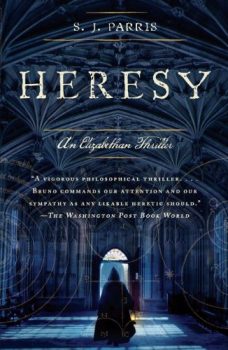
Britain during the reign of Elizabeth I (1533-1603) was wracked by turmoil and intrigue rooted in doctrinal differences between the newly independent Church of England and the deeply entrenched forces of Catholicism. To root out the many conspiracies mounted by her foreign and domestic enemies, the Queen’s principal private secretary, Sir Francis Walsingham (1532-90) operated an extensive network of spies. And in S. J. Parris‘s engaging historical spy thriller, Heresy, Walsingham recruits the famed Italian philosopher and mathematician Giordano Bruno (1548-1600) to spy on the dons of Oxford University during the time he spent on the island as a fugitive from the Inquisition.
This historical spy thriller in a nutshell
In the company of his friend, Sir Philip Sidney, Bruno makes his way to the cloistered environs of the university in May 1583. There, he quickly finds Walsingham’s fears that Catholic diehards remain hidden on the faculty are in all likelihood well-founded. Then Bruno chances upon the brutal murder of a Senior Fellow of Lincoln College, where he is lodging. Although the rector of the college insists on covering up evidence that the man was murdered, since disclosure would bring ill repute to the college, Bruno insists on looking into the matter himself.
Heresy (Giordano Bruno #1) by S. J. Parris (2010) 448 pages ★★★★☆
When a second, and later a third, murder turn up, a connection to the religious conflict becomes obvious. Each of the three victims was murdered in a manner modeled on that of a famous martyred Catholic saint—an imaginative departure from the facts of history that lends glamor to this historical thriller. With timely help from Philip Sidney, Bruno arrives at the truth after many harrowing encounters with the ruthless men who wish to see the Queen dead.
Religious conflict in Elizabethan England
Religious conflict roiled England throughout the sixteenth century. It was, after all, the era of the Reformation—Luther posted his 95 Theses in 1517—when the newly minted Protestants fought for keeps with the established Catholic Church throughout Germany, France, and the Low Countries. But in Britain the lechery of King Henry VIII created special circumstances when, failing to secure the Pope’s dispensation for him to divorce Catherine of Aragon and marry commoner Anne Boleyn, he separated the Church of England from Rome in 1534.
Already hungering for revolt, the leading Catholic families of the island grew incandescent with fury when Henry dispossessed the richest of the monasteries, seizing their treasure for his own. Catholic lords and officials gained a measure of revenge following Henry’s death and that of his young son when his daughter by Queen Catherine came to the throne. Queen Mary (“Bloody Mary”) quickly instituted an orgy of retribution during her brief reign (1553-58), burning more than 280 religious dissenters at the stake. Little wonder that when her Protestant half-sister, Elizabeth, ascended to the throne, tempers were at the boiling point. Surely, these circumstances can easily justify an historical spy thriller like this one.
The facts from history
A renegade monk of the Dominican order, Giordano Bruno had been on the run from the Inquisition since 1576. For seven years, he wandered through Italy, France, and Switzerland, supporting himself as a lecturer at a series of universities. In 1583 he traveled to England but left two years later, returning to Paris, where he enjoyed the patronage of King Henri III. Eventually, he turned up again in Italy and, in 1593, he was arrested for blasphemy and heresy. Following seven years of imprisonment, he was burned at the stake by the Roman Inquisition in 1600.
Bruno did, in fact, visit the University of Oxford in 1583 in the company of his friend Sir Philip Sidney. There, as in the novel, he came into conflict with the rector of Lincoln College, John Underhill, the future bishop of Oxford, and prominent Senior Fellows. The bone of contention was Bruno’s support for the work of Copernicus and his even more controversial insistence that the universe is infinite and abounds with life. Although he had hoped to secure a faculty position at the university, he was unable to do so.
It is also a fact that, during his two-year stay in England, Bruno did work as a spy under a pseudonym for Walsingham against Catholic conspirators. History does not record Bruno’s having solved any murders. But in so many other respects, this otherwise fanciful historical spy thriller reflects the facts as we know them.
For further reading
Heresy is just one of the many books I’ve reviewed that feature people in the role of detectives who are well known for other reasons. You’ll find my reviews at Famous people as detectives in fact and fiction. And if you’re looking for exciting historical novels, check out Top 10 historical mysteries and thrillers reviewed here.
You might also enjoy my posts:
- The 10 top espionage novels reviewed on this site
- 20 good nonfiction books about espionage
- Top 10 mystery and thriller series
If you enjoy reading spy thrillers, consider dipping into the work of these other excellent authors:
- Joseph Kanon’s spy thrillers are superb
- Dame Stella Rimington’s Liz Carlyle series of top-notch espionage novels
- The evocative Night Soldiers series from Alan Furst
- The spellbinding thrillers of Robert Harris
- The Maisie Dobbs novels from Jacqueline Winspear
- Top-notch spy novels from Alex Gerlis
- The 12 novels of Alex Berenson’s thrilling John Wells spy series
And you can always find my most popular reviews, and the most recent ones, plus a guide to this whole site, on the Home Page.



























